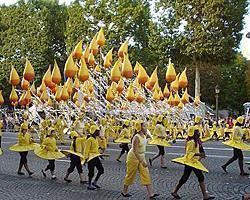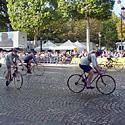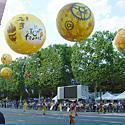Recently on Cyclingnews.com
|
 Bayern Rundfahrt Bayern Rundfahrt
Photo ©: Schaaf
|
| |
|
90th Tour de France - July 5-27, 2003
A Votre Tour
Honouring 100 years of Le Tour
By Gabriella Ekström
One of the first
Photo: © Alain Quenderf
 |
To honour all the riders who have been a part of the creation of the world's
greatest race, the Centenary Tour de France concluded with a three kilometre
parade over the legendary finish along the Champs Elysées. 1250 volunteers participated
in the parade that not only represented the "convicts of the tarmac", but also
the history of every race since the start of the Tour, with 300 children watching
the riders go by, representing the emotions of all the children who stood by
the roadside over the last 100 years.
Thanks to private collectors and carmakers, the many vehicles in the parade
all marked the year they represent, and clothes and decor have been carefully
stylised to agree with the fashions of each period. Carrying banners with names
of well-known cities and riders, amateur cyclists and roller-blade skaters rode
down the 'Champs' to the soundtracks and voices of radio and TV-journalists
who have all made their mark on the Tour de France.
To quote the French author Yvan Audouard, "During the Tour de France, the muscles
may tire, but the tongue gains strength. Jacques Goddet and the sports journalists
have earned their literature."
Cars with special effects of rain, snow and mist is a reminder of some of the
conditions met by the riders over the hundred years of racing. In 1926 for example,
riders faced a 326 kilometre stage in the Pyrenées between Bayonne and Luchon,
only 20 riders managed to find their way through the freezing rain in the mountains
to the finish in Allées d'Etigny, and when dark fell, numerous riders still
lost in the high mountains had to searched for by bus.
How the Tour began
To outdo his number one competitor Pierre Giffard, the directeur of
Le Velo and organiser of Paris-Brest-Paris, Henri Desgrange - directeur
of L'Auto - needed something very extraordinaire. Géo Lefevre, a trusted
collaborator, suggested a long distance race of even greater measurements
than P-B-P.
So on July 1, 1903, 61 riders dressed in their town suits gathered outside
the cafe Au Réveil Matin in Montgeron outside Paris. At 16 minutes past
three in the afternoon, they boarded their bikes to take on a three week
tour of France. Of all the starters, only 21 survived the six stages through
Montgeron, Lyon, Marseille, Toulouse, Bourdeaux, Nantes and Ville d'Avray.
Winner of the first Tour ever was Val d'Aoste-born Maurice Garin, almost
three hours ahead of second placed Lucien Pothier.
In only its second year, the Tour was disrupted by barricaded roads and
serious assaults on the riders. "The Tour de France has had its day,"
wrote a disillusioned Henri Desgrange, never knowing that his race would
last for another hundred years.
|
"When we got down from the bike, we fell out of our socks and shorts, with
nothing sticking to our bodies. What we wouldn't do to a donkey, we did to ourselves,"
was a phrase used by some cyclists of old. It shows the agony and pain that
the riders had to fight with on a daily basis in their attempt not only to remain
in the race, but also to make the race immortalise them.
Alongside the recreational riders and the one hundred professional actors,
an essential part of the parade was made up by the 22 out of 53 Tour de France
winners who are still alive, as well as the 147 riders who survived the fastest
and one of the most spectacular editions of the Tour ever, the 2003 Tour de
France.
The many faces that have worn the maillot
jaune
Photo: © Alain Quenderf
 |
One of the attributes most closely connected to the Tour is the leader's yellow
jersey, otherwise known as the maillot jaune. Although sporting the same colour
as L'Auto magazine, the jersey did not become a part of the Tour until 1919,
and at first, was not looked upon with great enthusiasm - at least not by the
man who had the honour of becoming the first maillo jaune ever. Frenchman Eugene
Christophe thought he was too easily recognised by the other riders in the field
while wearing the bright yellow outfit, but the jersey had come to the race
to stay.
Another parade was introduced in 1930 to finance the participation of competitors:
La Caravane du Tour de France. The publicity caravan has been a part of the
Tour ever since, and preceeds the riders on the parcours to the enjoyment of
the many million spectators that follow the race from the roadside each July.
After the second World War, the Tour de France company rebuilt the race together
with Parisien and l'Equipe, and it is in this era that exists Tour winners that
are still alive today. Ferdi Kubler, winner of the Tour in 1950 and 51, and
Roger Walkowiak, winner in 1956, were honoured in a 260 metres long scene that
also sported the gigantic front pages of the two papers from that time.
In 1957, a 23 year old rider took the final place on the French team after
Louison Bobet dropped out. His name was Jacques Anquetil, who would go on to
win five Tours de France. He applied a technique similar to that used by modern-day
hero Miguel Indurain, where he contained the climbers in the mountains and defeated
them in the time trials. Maître Jacques died in 1987, so instead, riders like
Charly Gaul and Federico Bahamontes are celebrated on the sunny avenue of the
Champs Elysées to the tunes of Jerry Lee Lewis' "Great Balls of Fire".
The many faces that have worn the maillot
jaune
Photo: © Alain Quenderf
 |
To find a place identical to Champs Elyseés for the rehearsal, participants
trained for a week at a rented airfield in Melun, just outside of Paris. Fifty
event directors worked alongside twenty wardrobe staff and every scene in the
final set up was closely supervised by an assistant producer, a director and
at least three other assistants.
The second rider to win five Tours was Eddy Merckx, who also holds the record
of 96 maillot jaunes, as well as 34 stage victories. The scene of the seventies
was marked by peace & love, and also paid homage to Bernard Thevenet, winner
in 1975 and 77, and Lucien Van Impe, winner in 1976.
Just like Anquetil and Merckx, Bernard Hinault also made his debut in the tour
with a victory. Aside from his five overall victories, his palmares also included
two runner-up placings, a feat unmatched to this day. According to his sport
directeur, Cyrille Guimard, Hinault was the most gifted of them all, a "Champion
of Champions". The 90s also cemented the epic time trial from Versailles to
Paris in 1989 in Tour memory. Still the fastest Tour time trial stage of all
times, with an average speed of 54.54 kilometres per hour, saw Greg LeMond strip
the yellow jersey off Laurent Fignon's shoulders by just eight seconds. It remains
the smallest winning margin in the Tour's history.
Au revoir, until next year
Photo: © Alain Quenderf
 |
Miguel Indurain was the only rider to win five consecutive Tours de France
before Lance Armstrong equalled this achievement just a few days ago, winning
the 2003 edition. The Spanish rider from Pamplona adopted a similar technique
to that of Jacques Anquetil, and in the scene of 1990's, Indurain is celebrated
alongside Bjarne Riis, Jan Ullrich and Marco Pantani.
The last scene of the Tour parade is totally devoted to Lance Armstrong and
his five triumphs, and it also represents the end of one decade and the beginning
of another. It honours the participation of cyclists from countries outside
the old-school cycling Europe. Riders from the United States, Australia, Ireland,
Scandinavia, South America and Eastern Europe have now all participated and
succeeded at the Tour.
Henri Jeanson, French writer and movie scriptwriter, once wrote about the Tour
in this way: "It's wonderful, it's unheard of, it's extraordinary, it's comical,
it's extravagant, it's magnificent. And it's very tiring. The Tour de France
is the most wonderful and complete of spectacles."
If you want the best view, you
have to work for it
Photo ©: Alain Quenderf

|
|
Laurent Brochard (FAg2R Prevoyance)
heads for the finish
Photo ©: Alain Quenderf

|
|
One of many vehicles depicting
the legends of the race
Photo ©: Alain Quenderf

|
|
A displaey re-enacts the first
Tour; it also rode past a canvas painting of a building
Photo ©: Alain Quenderf

|
|
A water-tanker cools down the over-excited
performers
Photo ©: Alain Quenderf

|
|
The race this performance depicts
either finished in the rain, or caught fire
Photo ©: Alain Quenderf

|
|
An extra from Mad Max 4: Velodrome,
chases down the riders
Photo ©: Alain Quenderf

|
|
A replica tower sprints for the
finish
Photo ©: Alain Quenderf

|
|
Unicycles were banned from the
Tour in 1915
Photo ©: Alain Quenderf

|
|
Oompah-Loompahs march in their
native yellow dress
Photo ©: Alain Quenderf

|
|
The Oompah-Loompahs And their yellow
balloons
Photo ©: Alain Quenderf

|
|
One of the performers got a little
carried away
Photo ©: Alain Quenderf

|
|
But she hung in there, and didn't
let the accident affect the performance
Photo ©: Alain Quenderf

|
|
At least she had a great view
Photo ©: Alain Quenderf

|
|
A replica rider on a replica bike
Photo ©: Alain Quenderf

|
|
Tour
de France homepage
|
|

















